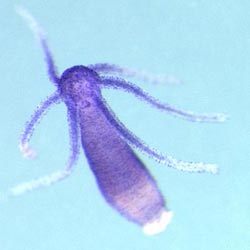Seeing without eyes: Hydra stinging cells respond to light

This is the fresh water polyp, Hydra magnipapillata. Credit: Dr. David Plachetzki, University of California<br>
They are diurnal, hunting during the day, and are known to move, looping end over end, or contract, in response to light. New research published in BioMed Central's open access journal BMC Biology shows that stinging cells (cnidocytes) in hydra tentacles, which the animals use for self protection and to catch prey, are linked via a simple nervous system to primitive light responsive cells that co-ordinate the animals' feeding behavior.
Hydra are members of a family of radially symmetric animals (Cnidaria), all of which use specialized cnidocytes to catch prey. This family also includes well-known creatures such as jellyfish and corals, which, like other cnidarians, have the simple design of a mouth surrounded by tentacles. Hydra tentacles contain barbed, poison containing cnidocytes that they use to stun animals like the water flea, Daphnia, before eating them alive, and to protect themselves from attack by other animals.
Researchers from the University of California lead by Dr David Plachetzki have discovered that the light sensitive protein opsin found in sensory cells is able to regulate the firing of harpoon-like cnidocytes. These light sensitive neurons are found integrated into arsenals that include the stinging cnidocytes as well as desmoneme cnidocytes, used to grasp prey, and sticky isorhiza, which help the hydra to summersault at 10cm a day.
The linking of opsin to cnidocytes explains how hydra are able to respond to light even though they do not have eyes. Dr Plachetzki described how other proteins necessary for phototransduction are also present in the sensory cells. “Not only did we find opsin in the sensory neurons that connect to cnidocytes in the hydra, but we also found other components of phototransduction in these cells. These included cyclic nucleotide gated ion channels (CNG) required to transfer the signal and a hydra version of arrestin, which wipes the phototransduction slate clean for a second signal.”
Dr Plachetzki continued, “We were also able to demonstrate that cnidocyte firing itself is effected by the light environment and that these effects are reversed when components of the phototransduction cascade are turned off.”
Cnidarians have been around for over 600 million years. However the hydra's simple approach to using light, to aid survival and increase their chances of catching prey, uses the same visual pathway as humans and hints at a common ancestor.
Notes to Editors
1. Cnidocyte discharge is regulated by light and opsin-mediated phototransduction
David C Plachetzki, Caitlin R Fong and Todd H Oakley
BMC Biology (in press)
Please name the journal in any story you write. If you are writing for the web, please link to the article. All articles are available free of charge, according to BioMed Central's open access policy.
Article citation and URL available on request on the day of publication.
2. BMC Biology is the flagship biology journal of the BMC series, publishing open-access, peer-reviewed research and methodology articles of special importance and broad interest in any area of biology, as well as reviews, opinion pieces, comment and Q&As on topics of special or topical interest.
3. BioMed Central (http://www.biomedcentral.com/) is an STM (Science, Technology and Medicine) publisher which has pioneered the open access publishing model. All peer-reviewed research articles published by BioMed Central are made immediately and freely accessible online, and are licensed to allow redistribution and reuse. BioMed Central is part of Springer Science+Business Media, a leading global publisher in the STM sector.
Media Contact
More Information:
http://www.biomedcentral.comAll latest news from the category: Life Sciences and Chemistry
Articles and reports from the Life Sciences and chemistry area deal with applied and basic research into modern biology, chemistry and human medicine.
Valuable information can be found on a range of life sciences fields including bacteriology, biochemistry, bionics, bioinformatics, biophysics, biotechnology, genetics, geobotany, human biology, marine biology, microbiology, molecular biology, cellular biology, zoology, bioinorganic chemistry, microchemistry and environmental chemistry.
Newest articles

Superradiant atoms could push the boundaries of how precisely time can be measured
Superradiant atoms can help us measure time more precisely than ever. In a new study, researchers from the University of Copenhagen present a new method for measuring the time interval,…

Ion thermoelectric conversion devices for near room temperature
The electrode sheet of the thermoelectric device consists of ionic hydrogel, which is sandwiched between the electrodes to form, and the Prussian blue on the electrode undergoes a redox reaction…

Zap Energy achieves 37-million-degree temperatures in a compact device
New publication reports record electron temperatures for a small-scale, sheared-flow-stabilized Z-pinch fusion device. In the nine decades since humans first produced fusion reactions, only a few fusion technologies have demonstrated…





















